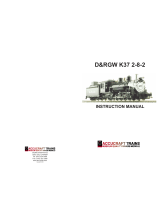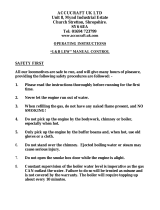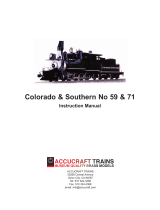Page is loading ...

ACCUCRAFT COMPANY
33268 Central Avenue
Union City, CA 94587
Tel: 510-324-3399
Fax: 510-324-3366
Email: [email protected]
Copyright 2012
Instruction Manual
D&RGW C-25 2-8-0
Electric & Live Steam

C-25
Prototype Information
This locomotive, a 2-8-0 or Consolidation type, originally existed as # 103 of the
Crystal River Railroad, a narrow gauge line located in the Elk Mountains of central
Colorado. It was built in 1903 as C/N 21757 of the Baldwin Locomotive Works, had
33” drivers, 18x20” cylinders, and a tractive effort just short of 25,000 pounds. It
was a standard Baldwin design, and other narrow gauge locos of this size and type
were built for railroads in the Western Hemisphere.
The D&RG purchased this locomotive from the Crystal River in 1916, numbered it #
432, this number subsequently being changed in 1924 to # 375. Originally the loco-
motive was a class 112, this number reflecting the total weight of the locomotive,
but eventually the D&RGW changed the classification numbers of their locomotives
to reflect their tractive effort, and thus the classification of C-25. Interestingly, for a
while the cab of this loco carried “C-25-112” as its classification.
The C-25 was affectionately known as the “Baby Mudhen” because its pull-
ing power was close to that of the K-27 class, those engines being known as
“Mudhens.” The 375 when it was put into service in 1916 was the best steamer
on the railroad at that time. Sadly, on June 21, 1949 the one and only C-25 on the
D&RGW was scrapped at Alamosa, Colorado.
by George Konrad
1
Notes
10

C-25 Live Steam
Technical Specifi cations
Live Steam
Scale/Gauge: 1:20.3, 45 mm Gauge
Length: 33.25 in. (845 mm)
Width: 6.44 in. (164 mm)
Height: 7.52 in. (191 mm)
Minimum Radius: 48 ins. 1.2 M
*Be sure to leave at least 3” clearance
(measured from the inner rail) to allow
for overhang.
Caution!
This model is an accurate replica of
the original locomotive. It has sharp
and moving parts. The locomotive
drive rods are stainless steel with
sharp edges. AT ANY TIME, OPERA-
TORS MUST NOT COME IN CON-
TACT WITH THE MODEL WHILE
IT IS POWERED. UNDER NO CIR-
CUMSTANCES SHALL ACCUCRAFT
TRAINS BE RESPONSIBLE FOR ANY
INCIDENTAL OR CONSEQUENTIAL
DAMAGES ARISING IN REGARD TO
ANY ACCUCRAFT PRODUCT.
Accucraft Trains locomotives are fi ne
scale brass models with small parts.
To provide maximum protection from
shipping damage, we carefully pack
the models in metal cases. We ship
via UPS with insurance coverage to its
full value. Please contact UPS if pack-
age is damaged.
Each locomotive is packed under
UPS guideline for shipping. We don
not warrant any damage resulted from
re-packaging by any party other than
Accucraft Trains.
Please read following directions be-
fore unpacking your locomotive.
1. Lift the box from the cardboard
box.
2. Place taped locomotive on a fl at
surface. Carefully cut the tape along
the wood board side surface. Be sure
to cut both sides of the wood board.
Slowly lift the tape from the locomo-
tive. Be very careful with small parts.
Tape cannot be re-used to re-pack the
model. Use new packing tape if nec-
essary.
9
C-25 Electric
2
Lubrication
Lubricants: always use quality
lubricants!
Light oil such as Labelle #108 or Wahl
Clipper Oil. Heavy lubricant such as
Labelle #102 heavy gear oil or Labelle
grease.
Prepare the engine for lubrication by
placing the model gently on the work
surface. To protect the locomotive
finish, place the engine on a piece of
foam sheet or soft towel. The engine
should be placed on its side. Be
careful to keep the lubricant off of the
painted surfaces, as this can leave
a shiny appearance on the area it
touches.
Oil all external moving parts of the
engine, including wheel bearings, with
a high grade, lightweight machine oil
like 3-in-1. Be sure to oil all parts of
the drive train. A little oil is all that’s
necessary.
It is a good idea to wipe off all excess
light oil when you complete the
lubrication process.
THIS LUBRICATION SHOULD BE
REPEATED AFTER EVERY 25 HOURS
OF OPERATION!
After following the recommended
lubrication procedures, your
locomotive is ready to provide many
years of enjoyment and reliable
operation. We recommend that you
use a D.C. power supply with a
capacity of 2.5 amps or larger and 24
volts.
Always pick your model up by grasping
it under the frame on both ends. It is
a very heavy model so make sure that
you grasp it firmly.
General maintenance
Clean the exterior surfaces of your
locomotive with a clean, soft and lint
free cloth.
The following parts are packaged sep-
arately
- M2 hex head screws
- 3 mm hex head screw driver
- Whistle pull cord

C-25 Electric
3
Tender Side
Please note the following diagram is for installation of aftermarket
sound system or smoke unit.
C-25 Live Steam
The compartment in the rear tank in
which the gas tank resides can be
fi lled with warm water in cooler weath-
er. This will warm the gas in the tank
and keep its pressure up, which will
cause the engine to operate in a much
more lively manner, much as it does
in warm weather. If the water in the
tank cools, just replace it with warmer
water. Empty the tender at the end of
the day’s run. Note: the temperature
of the fuel-supply-can must always be
higher than that of the engine’s gas
tank. If you have warmed the engine’s
gas tank and the supply can is cooler,
gas will not transfer. Never put boiling
hot water in the tender around the fuel
tank.
Notes on Radio Control
Although the C-25 was designed as a
manually controlled locomotive, there
is no reason why radio control (R/C)
cannot be fi tted, with some ingenuity.
A two channel radio is all that’s nec-
essary, one for the throttle and one
for the reversing lever. The gas valve
should always be controlled manu-
ally. The reversing lever will have to
be modifi ed so that it does not lock in
position, but it must still have stops at
either end of its throw for proper posi-
tioning of the reversing valve.
Safety
For your safety, there are certain rules
that should be observed, as follows:
1. The safety valve is under the steam
dome (the dome nearest the cab). It
has been set at the factory to release
at 60 pounds per square inch of pres-
sure. Never tamper with the safety
valve.
2. The fi ring system has been de-
signed to use butane gas only. Never
use any other gas (including propane
or butane/propane mix), as the storage
pressures can reach unsafe levels.
3. Always refuel the engine away from
other working live-steam locomotives.
The fuel fi lling system allows a small
amount of the gas to bleed off as the
fuel tank is being fi lled. A passing
engine can ignite this bleed-off gas,
causing a potentially hazardous situ-
ation.
4. When lighting up, light your match
fi rst, then turn on the gas.
5. A steam engine gets hot. Be care-
ful. The following parts are packaged
separately
- M3 hex head screws
- 3 mm hex head screw driver
- 5 ml syringe – steam oil
- 50 ml syringe - water
8

C-25 Live Steam
After another four or fi ve minutes,
pressure on the pressure gauge
should read about 20psi (pounds per
square inch) or so. The safety valve is
set at 60psi. When the pressure on the
gauge reaches 40psi, the engine can
be run.
Running
Open the cab roof for access to the
controls. Move the reversing lever at
the right side of the cab to the forward
position. With the engine on the track,
and without a train, open the throttle.
Because the cylinders are cold, the
hot steam entering them will condense
into water and be exhausted through
the stack. The engine may need to be
pushed a little to overcome the steam
condensing into water in the cold cyl-
inders. After a few moments, it should
take off on its own, moving away
smoothly.
Once the engine is running smoothly,
a train can be coupled on and the run
can proceed. Since all of the locomo-
tive’s functions are controlled from the
cab, it can be driven like a full-size
engine, meaning that you’ll have to
stay with the engine through the run if
you want to change its speed or direc-
tion. If you have a suitable track, the
engine can be left to run on its own
at a steady speed. Keep your eye on
the water glass. When the water level
drops, add water by pumping the hand
pump.
Shutting down
At the end of the day’s run, close the
throttle snugly. When cool, the safety
valve should be loosened to relieve
the vacuum that will be created in the
boiler. This vacuum could pull oil from
the lubricator into the boiler if the throt-
tle is not closed.
After a day’s operation in the garden
you’ll probably fi nd that your engine
has a coating of oil all over it. This is
steam-cylinder oil that has been ex-
hausted from the stack. A simple wipe
down with a dry cloth is all that’s nec-
essary to restore the engine to pristine
condition. This is best done while the
engine is still hot. Wipe any grit and
excess oil from the wheels and run-
ning gear.
The boiler can be drained of water, or
not, as you will. Leaving water in the
boiler will not harm it. The lubricator
can also be drained and refi lled with
steam oil in preparation for the next
run.
Cold-Weather Running
The weather can dramatically affect
the performance of your locomotive.
Cold and wind can decrease effi ciency
to a disappointing level. Butane gas
becomes liquid at 32°F and will not
work. As it approaches 32°F, its pres-
sure (and effectiveness) diminishes.
7
C-25 Electric
4
Loco Side

C-25 Live Steam
Preparing the engine
A steam-locomotive engineer goes
through a lighting-up ritual every time
the engine is to be run. It is good to
follow the same routine each time so
that nothing is overlooked.
1. Oil all external moving parts of the
engine, including wheel bearings, with
a high grade, lightweight machine oil
like 3-in-1. Be sure to oil all parts of the
drive train. A little oil is all that’s neces-
sary.
2. Place the engine on track.
3. The adjustable lubricator located
in the cab ensures the cylinders and
valves are properly lubricated inside.
The adjustable lubricator valve handle
should be open at least two full turns
when the engine is breaking in. The
break in period should be approx. two
hours. If you notice excessive oil use
after that period of time then close the
valve to one full turn.
As the steam passes through it, a
small amount will condense into
water. This water will sink to the bot-
tom of the lubricator, forcing a similar
quantity of oil into the steam line and
thus to the cylinders.
5
Gas line to locomotive
Water line to locomotive
Water fi ller plugLubricator
Water level gauge
Pressure gauge
Throttle
C-25 Live Steam
Remove the lubricator cap and draw
out any water from previous run with
a syringe. Use only proper steam cyl-
inder oil. Fill the lubricator, but leave
a small air space between the oil and
the cap.
4. Unscrew the fi ller plug and fi ll the
boiler to the top with water then pull
out 30 ml with large syringe. Use only
distilled water in your engine’s boiler.
Tap water contains minerals that will
leach out and ultimately affect the per-
formance of the engine.
5. Finally, add fuel. Your C-25 burns
butane gas. The gas tank is located
in the tender beneath the front hatch.
Butane gas can be purchased at the
grocery store or at a tobacconist’s as
cigarette-lighter refi lls. These come
with a nipple suitable for the fi ller valve
on the C-25’s gas tank. (Butane can
also be purchased in larger containers
at camping-supply stores, but these
cans will require a special adapter for
fi lling the engine’s tank.) Simply press
the nozzle of the butane canister hard
onto the fi ller valve atop the tank,
making sure that the control valve is
closed. You will hear the gas transfer-
ring and will see a little gas bleeding
out of the valve. When the tank is full,
the gas will begin to splutter and much
more gas will escape the valve. When
the gas tank is full you are ready to fi re
up the engine. Add 1” to 2” of water to
the rear tank. This will keep the tank
warm and the gas pressure up!
Firing up
Make sure the throttle is closed. The
engine’s burner resides at the back
of the fl ue inside the boiler. Open the
hinged smokebox door at the front of
the engine and you’ll be able to see
the fl ue. To light up, strike a match
and hold it at the open smokebox door
while simultaneously opening the gas
valve in the tender very slowly until the
gas ignites. You should hear the gas
coming into the burner. Opening the
valve too wide or too fast may blow
out the fl ame or cause the fi re to burn
in the smokebox.
The fi re should fl ash back into the
back of the fl ue with a quiet “pop”. If
it wants to burn in the smokebox or
in the forward part of the fl ue, slowly
close the gas valve until it fl ashes back
to the burner. Don’t let the fi re burn in
the smokebox - your engine will not
run as it should and may be damaged.
The fi re should burn under the burner
in a crescent-shaped fl ame, which
should be clearly visible through the
smokebox door. The fl ame should be
bright blue and should burn steadily.
If it sputters or looks yellow or green,
adjust the gas valve accordingly. The
object is to run the burner at the low-
est setting possible to operate the en-
gine, thereby increasing the effi ciency
of the engine and the duration of the
run. You’ll get the hang of this with
practice.
6
/

















